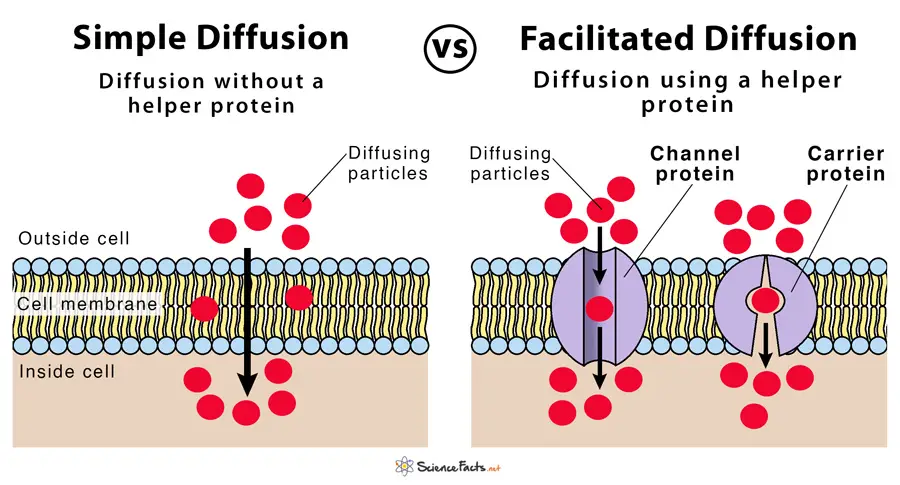Table of Contents
The major distinction between simple and facilited diffusion is that simple diffusion is not accompanied by the involvement of the channel or carrier proteins whereas the facilitated one takes place through channels or protein carrier proteins.
The simple diffusion process is the method which transports molecules from a region with a high concentration to another that is low in concentration. It happens on the gradient of concentration. Therefore, it doesn’t require energy. The method can be explained with an easy task. If you open a bottle of scent and the scent spreads quickly across the entire room through diffusion.
Similar to this, if you place an ink drop in a beaker that is filled with water color is evenly distributed throughout the water. The process of diffusion is not limited to these situations however, it can also occur in cells as well. But, in some cases, when larger molecules are able to diffuse through the cell membranes, proteins associated with the membrane participate in the process of diffusion. This is known as Facilitated diffusion. It differs from simple diffusion because it involves membrane proteins, which are carriers or channels. In reality, both simple diffusion and the facilitated diffusion are based on the concentration gradient Both are non-passive processes.
What is Simple Diffusion?
Simple diffusion is an unassisted form of diffusion that occurs when particles are moved from greater to a lower concentration. The directional movement of the gradient of concentration is a passive process. When the molecules are evenly distributed, the molecules located on opposite side of the membrane reach an equilibrium in which there is no net movement of molecules is noticed. In general, non-polar molecules of small size such as carbon dioxide, oxygen and ethanol are able to freely move through the cell membrane. The rate of diffusion is dependent on molecular size, temperature and the intensity of the concentration gradient. The temperature affects the energy of the particles within the solution. Large particles will experience more resistance within the solution as compared to smaller particles. Furthermore in the event that concentration gradients are large there will be more molecules passing across the membrane.
What is Facilitated Diffusion?
Facilitated diffusion is the movement of substances across a membrane of a living organism via a concentration gradient using an underlying molecular. In facilitated diffusion, huge molecules and ions are dissolving in water and are specifically and in a passive manner transferred across cell membranes. Polar ions are transported through transmembrane channel proteins, and large molecules are transported through transmembrane-carrier proteins. Channel proteins form hydrophobic tunnels in the membrane, which allows selected molecules that are hydrophobic to pass across the membrane. Certain channel proteins are “open constantly and others like Ion channel proteins are “gated’. Permeases, the proteins that carry out transport, alter their shape as molecules such as amino acids or glucose move through them. Aquaporins are another type of transport proteins that permit water to pass through the membrane at such a speed.
Similarities Between Simple Diffusion and Facilitated Diffusion
- Simple and facilitated diffusion occurs along the gradient of concentration from the highest concentration to small amount of molecules.
- The two types of molecules do not require energy to facilitate the transport of molecules.
- The net movement of molecules along each side of the membrane of the cell is 0 in equilibrium.
Difference Between Simple Diffusion and Facilitated Diffusion (Simple diffusion vs facilitated diffusion)

